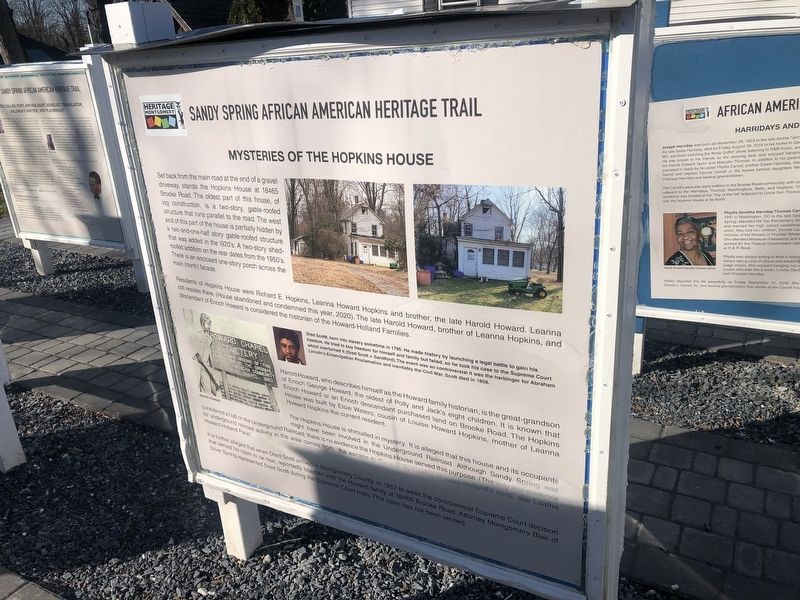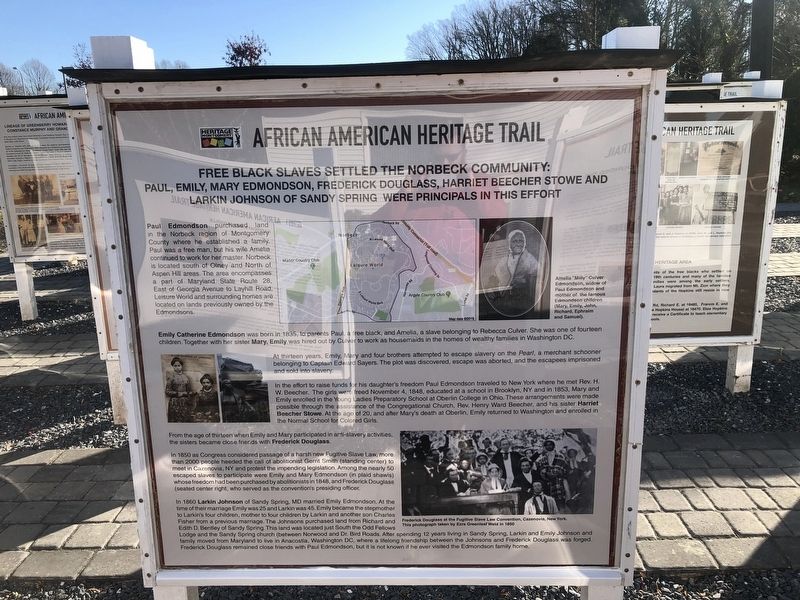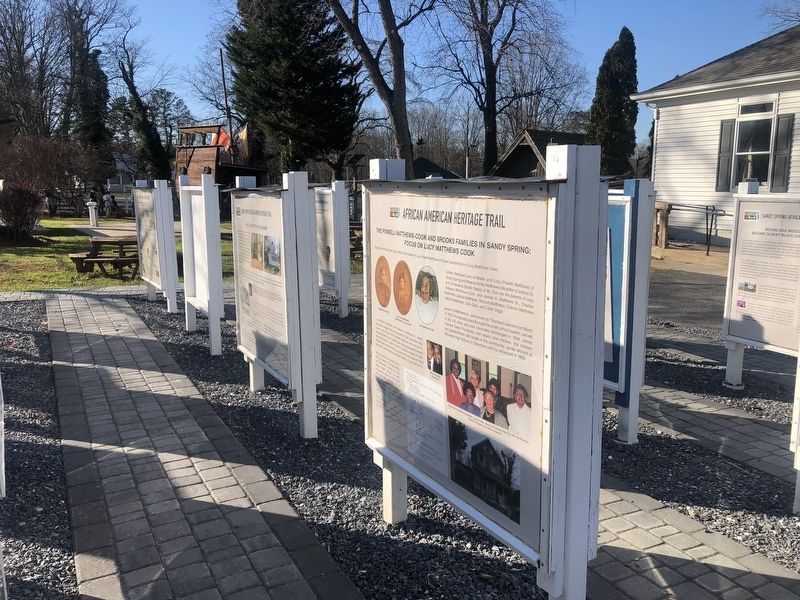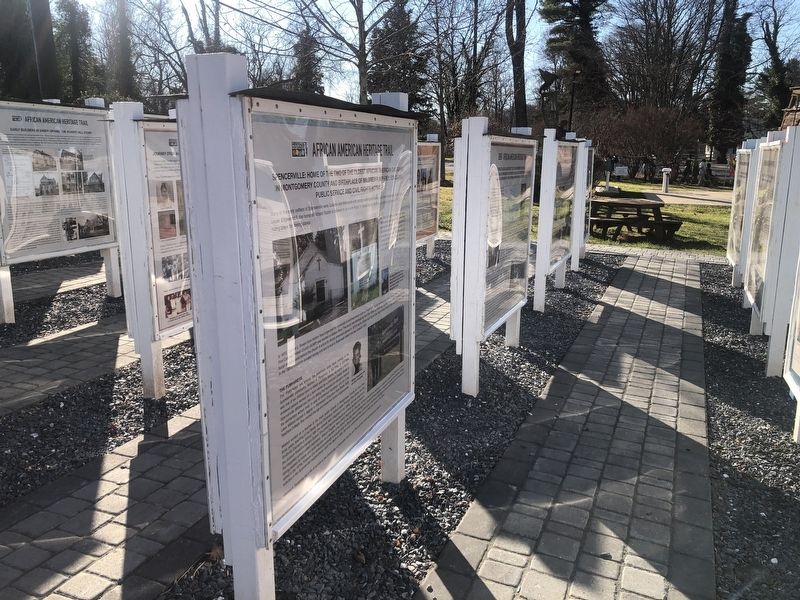Sandy Spring in Montgomery County, Maryland — The American Northeast (Mid-Atlantic)
Mysteries of the Hopkins House / Free Black Slaves Settled the Norbeck Community
Sandy Spring African American Heritage Trail
— [Sandy Spring Slave Museum & African Art Gallery] —

Photographed By Devry Becker Jones (CC0), December 12, 2021
1. Mysteries of the Hopkins House side of the marker
Mysteries of the Hopkins House
Set back from the main road at the end of a gravel driveway, stands the Hopkins House at 18465 Brooke Road. The oldest part of this house, of log construction, is a two-story, gable-roofed structure that runs parallel to the road. The west end of this part of the house is partially hidden by a two-and-one-half story gable-roofed structure that was added in the 1920's. A two-story shed-roofed addition on the rear dates from the 1950's. There is an enclosed one-story porch across the main (north) facade.
Residents of Hopkins House were Richard E. Hopkins, Leanna Howard Hopkins and brother, the late Harold Howard. Leanna still resides there. (House abandoned and condemned this year, 2020). The late Harold Howard, brother of Leanna Hopkins, and descendant of Enoch Howard is considered the historian of the Howard-Holland Families.
Dred Scottt, born into slavery sometime in 1795. He made history by launching a legal battle to gain his freedom. He tried to buy freedom for himself and family but failed, so he took his case to the Supreme Court which overturned it (Dred Scott v. Sanford). The event was so controversial it was the harbinger for Abraham Lincoln's Emancipation Proclamation and inevitably the Civil War. Scott died in 1858.
Harold Howard, who describes himself as the Howard family historian, is the great-grandson of Enoch George Howard, the oldest of Polly and Jack's eight children. It is known that Enoch Howard or an Enoch descendant purchased land on Brooke Road. The Hopkins House was built by Elsie Waters, cousin of Louise Howard Hopkins, mother of Leanna Howard Hopkins the current resident.
The Hopkins House is shrouded in mystery. It is alleged that this house and its house might have been involved in the Underground Railroad. Although Sandy Spring was considered a hub on the Underground Railroad, there is no evidence the Hopkins House served this purpose. (The only real evidence for underground railroad activity in the area comes from the escape to Canada by Leatha Howard Holland's sons, see Leatha Hoard Holland Panel).
It is further alleged that when Dred Scott arrived in Montgomery County in 1857 to await the controversial Supreme Court decision that denied his claim to be free, reportedly boarded with the Howard family at 18465 Brooke Road. Attorney Montgomery Blair of Silver Spring represented Dred Scott during the Supreme Court trials. This claim has not been verified.
Free Black Slaves Settled the Norbeck Community:
Paul Emily, Mary Edmondson, Frederick Douglass, Harriet Beecher Stowe and Larkin Johnson of Sandy Spring Were Principals in This Effort
Paul

Photographed By Devry Becker Jones (CC0), December 12, 2021
2. Free Black Slaves Settled the Norbeck Community side of the marker
Emily Catherine Edmondson was born in 1835, to parents Paul, a free black, and Amelia, a slave belonging to Rebecca Culver. She was one of fourteen children. Together with her sister Mary, Emily was hired out by Culver to work as housemaids in the homes of wealthy families in Washington DC.
At thirteen years, Emily, Mary and four brothers attempted to escape slavery on the Pearl, a merchant schooner belonging to Captain Edward Sayers. The plot was discovered, escape was aborted, and the escapees were imprisoned and sold into slavery.
In the effort to raise funds for his daughter's freedom Paul Edmondson traveled to New York where he met Rev. H.W. Beecher. The girls were freed November 4, 1848, educated at a school in Brooklyn, NY and in 1853, Mary and Emily enrolled in the Young Ladies Preparatory School in Oberlin College in Ohio. These arrangements were made possible through the assistance of the Congregational

Photographed By Devry Becker Jones (CC0), December 12, 2021
3. Mysteries of the Hopkins House side of the marker
From the age of thirteen when Emily and Mary participated in anti-slavery activities, the sisters became close friends with Frederick Douglass.
In 1850 as Congress considered passage of a harsh new Fugitive Slave Law, more than 2000 people heeded the call of abolitionist Gerrit Smith (standing center) to meet in Cazenovia, NY and protest the impending legislation. Among the nearly 50 escaped slaves to participate were Emily and Mary Edmondson (in plaid shawls) whose freedom had been purchased by abolitionists in 1848, and Frederick Douglass (seated center right, who served as the convention's presiding officer.
In 1860, Larkin Johnson of Sandy Spring, MD married Emily Edmondson. At the time of their marriage Emily was 25 and Larkin was 45. Emily became the stepmother to Larkin's four children, mother to four children by Larkin and another son Charles Fisher from a previous marriage. The Johnsons purchased land from Richard and Edith D. Bentley of Sandy Spring. This land was located just South the Odd Fellows Lodge and the Sandy Spring church (between Norwood and Dr. Bird Roads. AFter spending 12 years living in Sandy Spring,

Photographed By Devry Becker Jones (CC0), December 12, 2021
4. Free Black Slaves Settled the Norbeck Community side of the marker
Erected by Sandy Spring Slave Museum & African Art Gallery.
Topics. This historical marker is listed in these topic lists: Abolition & Underground RR • African Americans • Law Enforcement • Notable Buildings • Settlements & Settlers • Waterways & Vessels • Women. A significant historical date for this entry is November 4, 1848.
Location. 39° 9.58′ N, 77° 1.973′ W. Marker is in Sandy Spring, Maryland, in Montgomery County. Marker is on Brooke Road, 0.1 miles west of Chandlee Mill Road, on the right when traveling west. Touch for map. Marker is at or near this postal address: 18524 Brooke Rd, Sandy Spring MD 20860, United States of America. Touch for directions.
Other nearby markers. At least 8 other markers are within walking distance of this marker. The Powell-Matthews-Cook and Brooks Families in Sandy Spring / Spencerville (here, next to this marker); Brookeville - Mt. Zion / Early Builders in Sandy Spring: The Robert Hill Story (here, next to this marker); The Williams and Claggett Families in Ashton / Lineage of Greenberry Howard Family (here, next to this marker); Sadie Matthews Budd and Family / The Bowens, Mitchells and Jacksons of Ashton and Baltimore, MD (here, next to this marker); Cincinnati, Largest African American Settlement / Journey from Alloway to Sandy Spring (here, next to this marker); Leatha Howard Holland Webster / William Howard Hill & Anna Virginia Carter Hill (here, next to this marker); Enoch George Howard and John Henry Howard / The Dorsey, Williams and Johnson Connections (here, next to this marker); Woodlawn Manor Cultural Park / The Hill's of Holly Grove / Lineage of the Hill Family (here, next to this marker). Touch for a list and map of all markers in Sandy Spring.
Additional keywords. Dred Scott
Credits. This page was last revised on March 9, 2023. It was originally submitted on December 15, 2021, by Devry Becker Jones of Washington, District of Columbia. This page has been viewed 611 times since then and 104 times this year. Photos: 1, 2, 3, 4. submitted on December 15, 2021, by Devry Becker Jones of Washington, District of Columbia.